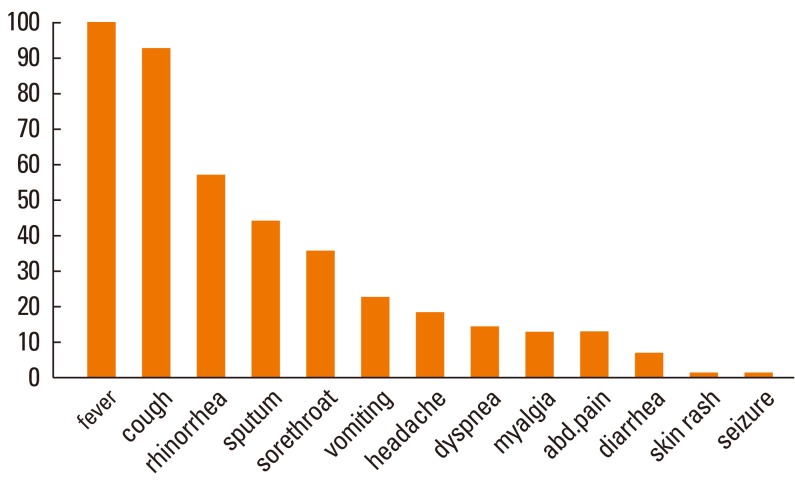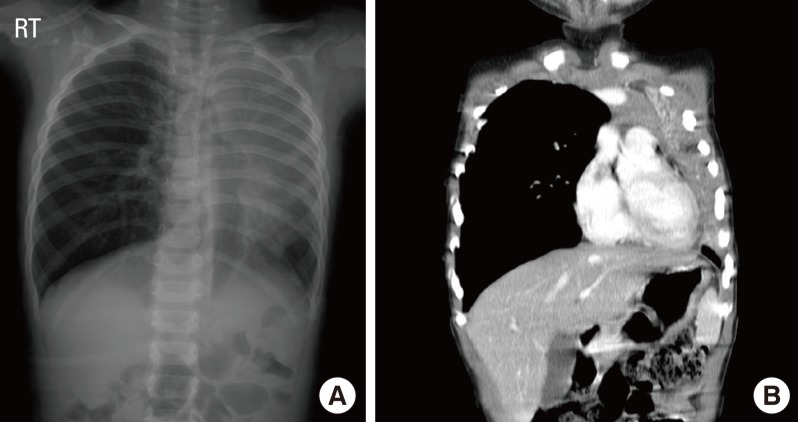Allergy Asthma Immunol Res.
2012 Sep;4(5):277-283. 10.4168/aair.2012.4.5.277.
Increased Prevalence of H1N1-Induced Severe Lower Respiratory Tract Diseases in Children With Atopic Sensitization
- Affiliations
-
- 1Department of Paediatrics, Kangbuk Samsung Hospital, Sungkyunkwan University School of Medicine, Seoul, Korea. jy7.shim@samsung.com
- KMID: 2167046
- DOI: http://doi.org/10.4168/aair.2012.4.5.277
Abstract
- PURPOSE
Viral infection is the most common aggravating factor for childhood asthma. Asthma may be a risk factor for severe respiratory symptoms in children with lower respiratory tract infections of viral etiology. Influenza A infection enhances Th2-polarization to house dust mites during the acute phase and leads to lung dysfunction in a mouse model. However, there are no data on the relationship between atopic sensitization and H1N1 (Influenza A) infection in humans. To investigate whether atopic sensitization is associated with the severity of H1N1 pneumonia, we compared clinical features and the atopic sensitization rate between children with and without H1N1 infection.
METHODS
Using reverse transcription-polymerase chain reactions, we investigated H1N1 virus infection in 214 children who were hospitalized with high fever and respiratory symptoms from September 2009 to February 2010. We also performed immunoassays for total and specific IgEs to six common aeroallergens. Atopy was defined as positivity for more than one specific IgE. The clinical severity of pneumonia was evaluated based on intensive care unit admission, oxygen therapy, steroid therapy, and atelectasis.
RESULTS
There were 70 H1N1-positive children, 42.9% of whom had pneumonia. Children with H1N1 infection were older and had a higher prevalence of atopic sensitization and pneumonia compared with H1N1-negative children. The rate of atelectasis was higher in children with H1N1 pneumonia than in children with non-H1N1 pneumonia. Among children with H1N1 viral infection, those with atopic sensitization had a higher prevalence of intensive care unit admission and oxygen therapy, and a longer duration of hospitalization than non-atopic children. There were no differences between atopic and non-atopic children without H1N1 viral infection.
CONCLUSIONS
The prevalence of H1N1-induced severe lower respiratory tract diseases is higher in children with atopic sensitization.
Keyword
MeSH Terms
-
Animals
Asthma
Child
Fever
Hospitalization
Humans
Immunoassay
Immunoglobulin E
Influenza A Virus, H1N1 Subtype
Influenza, Human
Intensive Care Units
Lung
Mice
Oxygen
Pneumonia
Prevalence
Pulmonary Atelectasis
Pyroglyphidae
Respiratory System
Respiratory Tract Diseases
Respiratory Tract Infections
Risk Factors
Immunoglobulin E
Oxygen
Figure
Reference
-
1. Novel Swine-Origin Influenza A (H1N1) Virus Investigation Team. Dawood FS, Jain S, Finelli L, Shaw MW, Lindstrom S, Garten RJ, Gubareva LV, Xu X, Bridges CB, Uyeki TM. Emergence of a novel swine-origin influenza A (H1N1) virus in humans. N Engl J Med. 2009; 360:2605–2615. PMID: 19423869.
Article2. Iskander M, Booy R, Lambert S. The burden of influenza in children. Curr Opin Infect Dis. 2007; 20:259–263. PMID: 17471035.
Article3. Dawood FS, Fiore A, Kamimoto L, Nowell M, Reingold A, Gershman K, Meek J, Hadler J, Arnold KE, Ryan P, Lynfield R, Morin C, Baumbach J, Zansky S, Bennett NM, Thomas A, Schaffner W, Kirschke D, Finelli L. Emerging Infections Program (EIP) Network. Influenza-associated pneumonia in children hospitalized with laboratory-confirmed influenza, 2003-2008. Pediatr Infect Dis J. 2010; 29:585–590. PMID: 20589966.
Article4. Schrag SJ, Shay DK, Gershman K, Thomas A, Craig AS, Schaffner W, Harrison LH, Vugia D, Clogher P, Lynfield R, Farley M, Zansky S, Uyeki T. Emerging Infections Program Respiratory Diseases Activity. Multistate surveillance for laboratory-confirmed, influenza-associated hospitalizations in children: 2003-2004. Pediatr Infect Dis J. 2006; 25:395–400. PMID: 16645501.5. Finelli L, Fiore A, Dhara R, Brammer L, Shay DK, Kamimoto L, Fry A, Hageman J, Gorwitz R, Bresee J, Uyeki T. Influenza-associated pediatric mortality in the United States: increase of Staphylococcus aureus coinfection. Pediatrics. 2008; 122:805–811. PMID: 18829805.
Article6. Mahut B, Refabert L, Marchac V, Iniguez JL, Aubertin G, Tamalet A, Lebras MN, Troadec C, Chatellier G, Delclaux C. Influenza-like illness responsible for severe exacerbations in asthmatic children during H1N1 pandemic: a survey before vaccination. J Asthma. 2011; 48:224–227. PMID: 21332420.
Article7. Hasegawa S, Hirano R, Hashimoto K, Haneda Y, Shirabe K, Ichiyama T. Characteristics of atopic children with pandemic H1N1 influenza viral infection: pandemic H1N1 influenza reveals 'occult' asthma of childhood. Pediatr Allergy Immunol. 2011; 22:e119–e123. PMID: 21342277.
Article8. O'Riordan S, Barton M, Yau Y, Read SE, Allen U, Tran D. Risk factors and outcomes among children admitted to hospital with pandemic H1N1 influenza. CMAJ. 2010; 182:39–44. PMID: 19926677.9. Stensballe LG, Kristensen K, Simoes EA, Jensen H, Nielsen J, Benn CS, Aaby P. Danish RSV Data Network. Atopic disposition, wheezing, and subsequent respiratory syncytial virus hospitalization in Danish children younger than 18 months: a nested case-control study. Pediatrics. 2006; 118:e1360–e1368. PMID: 17079537.
Article10. Jung JA, Kita H, Yawn BP, Boyce TG, Yoo KH, McGree ME, Weaver AL, Wollan P, Jacobson RM, Juhn YJ. Increased risk of serious pneumococcal disease in patients with atopic conditions other than asthma. J Allergy Clin Immunol. 2010; 125:217–221. PMID: 20109748.
Article11. Munster VJ, de Wit E, van den Brand JM, Herfst S, Schrauwen EJ, Bestebroer TM, van de Vijver D, Boucher CA, Koopmans M, Rimmelzwaan GF, Kuiken T, Osterhaus AD, Fouchier RA. Pathogenesis and transmission of swine-origin 2009 A(H1N1) influenza virus in ferrets. Science. 2009; 325:481–483. PMID: 19574348.
Article12. Jain S, Kamimoto L, Bramley AM, Schmitz AM, Benoit SR, Louie J, Sugerman DE, Druckenmiller JK, Ritger KA, Chugh R, Jasuja S, Deutscher M, Chen S, Walker JD, Duchin JS, Lett S, Soliva S, Wells EV, Swerdlow D, Uyeki TM, Fiore AE, Olsen SJ, Fry AM, Bridges CB, Finelli L. 2009 Pandemic Influenza A (H1N1) Virus Hospitalizations Investigation Team. Hospitalized patients with 2009 H1N1 influenza in the United States, April-June 2009. N Engl J Med. 2009; 361:1935–1944. PMID: 19815859.
Article13. Suzuki S, Suzuki Y, Yamamoto N, Matsumoto Y, Shirai A, Okubo T. Influenza A virus infection increases IgE production and airway responsiveness in aerosolized antigen-exposed mice. J Allergy Clin Immunol. 1998; 102:732–740. PMID: 9819289.
Article14. Sato F, Nakazawa M, Yamamiya S, Tamura C, Hongo N, Hotta C, Minami M. Effect of BSA antigen sensitization during the acute phase of influenza A viral infection on CD11c+ pulmonary antigen presenting cells. Allergol Int. 2009; 58:445–454. PMID: 19628980.
Article15. Jensen JR, Sand TT, Jørgensen AS, Thestrup-Pedersen K. Modulation of natural killer cell activity in patients with atopic dermatitis. J Invest Dermatol. 1984; 82:30–34. PMID: 6418828.
Article16. Jeon MH, Chung JW, Choi SH, Kim TH, Lee EJ, Choo EJ. Pneumonia risk factors and clinical features of hospitalized patients older than 15 years with pandemic influenza A (H1N1) in South Korea: a multicenter study. Diagn Microbiol Infect Dis. 2011; 70:230–235. PMID: 21596224.
Article
- Full Text Links
- Actions
-
Cited
- CITED
-
- Close
- Share
- Similar articles
-
- Prevalence of respiratory viral infection in children hospitalized for acute lower respiratory tract diseases, and association of rhinovirus and influenza virus with asthma exacerbations
- The Effect of Antigen Sensitization and Development of Respiratory Allergy Disease on Severity of Atopic Dermatitis
- Atopic Sensitization is Associated With Severe Lower Respiratory Illness in Children With Pandemic H1N1 Influenza Viral Infection
- Determinants of sensitization to allergen in infants and young children
- Positive conversion of specific IgE against house dust mite in children with atopic dermatitis under 24 months of age



